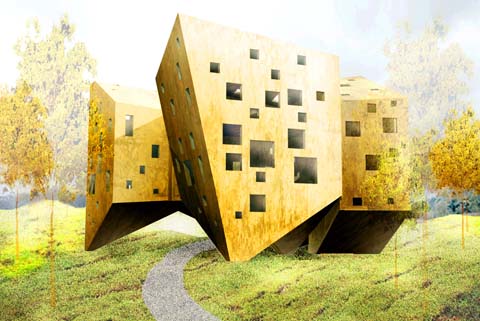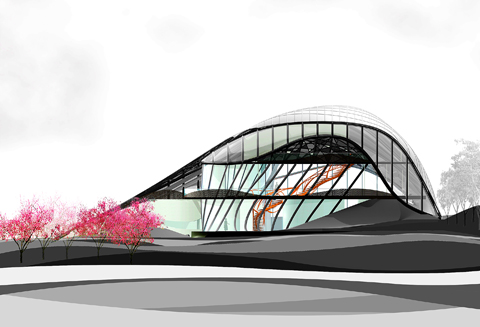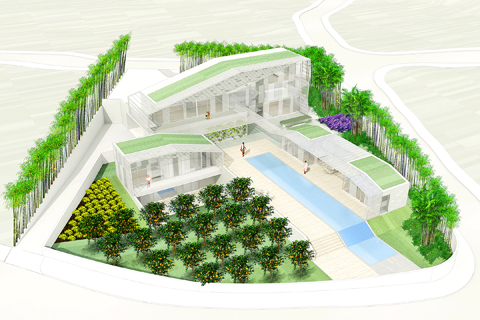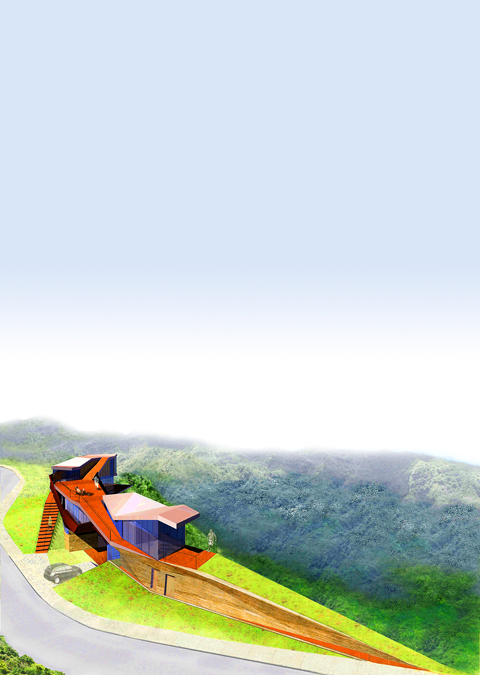A house whose structure was inspired by a Matisse painting, a dwelling that creates “architecture out of nature,” a residential compound that emphasizes a healthy lifestyle and the traditional Taiwanese family unit — these are just a few of the designs and themes explored by some of the world’s top architects for a project located in Taipei County’s Aodi (台北縣澳底), a fishing port on Taiwan’s northeast coast.
The project, called Next Gene20, is the work of 10 international and 10 Taiwanese architects who gathered at Taipei’s XueXue Institute (學學文創志業) last week to present their creations. Next Gene20 has already gained attention in the architecture and design world: the project has been invited to the prestigious La Biennale di Venezia, one of Europe’s top art fairs and one of the world’s most influential architecture exhibitions. The project’s houses are slated to begin construction next year and will be completed by 2010.
‘Next generation’ lifestyles

PHOTO COURTESY OF NEXT GENE20
“Just as you [in Taiwan] are proud of having the world’s tallest [occupied] building, you should also be proud of this project,” said Toshiko Mori, chair of the Department of Architecture at Harvard University’s Graduate School of Design, and one of the Next Gene20 architects, at the press conference.
One of the project’s main goals is to “explore the concept of ‘next generation’ lifestyles and the relationship between architecture and landscape,” said Liu Yu-tung (劉育東), Next Gene20’s head architect and vice-president of Asia University (亞洲大學) in Taichung County (台中縣).
“They’re strange buildings,” Liu said in a phone interview, since the houses don’t look like typical vacation homes. But they are cutting-edge, he said, for their “experimental” architecture, and as such, are aimed at affluent Taipei residents looking for a weekend getaway or second home. Many of the residences are eye-catching for their non-linear shapes, curved lines and glass walls.

PHOTO COURTESY OF NEXT GENE20
Liu, who holds a doctorate in design from Harvard, said he is proud of the outcome of the Next Gene20. The project’s A-list architects, who hail from the US, Europe, Japan, South Korea, China and Taiwan, have all “put in more effort than I could have ever imagined,” he said.
He added that the final product has turned out to be “theoretically strong,” which has attracted the interest of one of the industry’s major magazines, A+U (Architecture and Urbanism), which is devoting a full issue to the project.
Liu said Taiwanese architecture would benefit from Next Gene20. It has provided new “platforms” that raise the visibility of Taiwanese architects and connects them with an international network.

PHOTO COURTESY OF NEXT GENE20
Standing out
In the architecture world, the project is exceptional for what Liu called its “group creation” concept, in which the 20 architects formed an artistic “dialogue.” The group dynamic also inspired “positive competition” and heightened creativity among the architects, he said.
According to Liu, Next Gene20 also represents a “turning point” for architecture in Taiwan, which is advancing in two directions. The first is that the public and government sector in Taiwan have started to engage high-profile architects such as Toyo Ito of Japan, who designed the Taichung Metropolitan Opera House (台中大都會歌劇院). The second is more investment from private construction corporations, as in the case of Next Gene20, which was initiated by Lu Tai-nien (呂台年), chairman of the Genuine Group (捷年集團).

PHOTO COURTESY OF NEXT GENE20
Among Next Gene20’s notable works is Kung Shu-chang’s (龔書章) Radix House, which was inspired by Henri Matisse’s painting, Dance. The house looks like five giant, pointed stones standing together; like Matisse’s dancers, who each stand on one foot, the structure rests on the tip each “stone,” thus minimizing damage to the ground below. Kung’s house is also intended to foster an appreciation of the surroundings — the south side has large windows for viewing the forest. As for environmental considerations, the east and west sides of the house have small windows to shield it from wind in winter and sunlight in summer.
Blending in
Julien de Smedt’s Twirl House, on the other hand, literally blends into the landscape. Its structure is weaved into gently sloping hills — the roofs are shaped like arches with grass growing on top. His design took into consideration the constant changes in vegetation and soil due to typhoons to make his house “in symbiosis with the environment,” de Smedt said. The sides of the house are mostly window glass, but their placement is arranged so that it is easy to see out, but not in. “[The house] celebrates views and protects itself from being viewed,” de Smedt said at the press conference.
Despite the radical look, the Denmark-based architect says his team worked with “excellent local architects and consultants to make sure our house embodied Taiwanese values.” A resident of the house will feel “happy to live there,” de Smedt said later in an e-mail exchange.
Flexivilla is Toshiko Mori’s reaction to Taipei’s urban density: she designed a compound-like space with a grand feel, so both the building and its occupants have space to “breathe.” Three pavilions are connected by covered walkways, allowing for outdoor activities even in inclement weather. This multi-pavilion design suits the traditional Taiwanese family unit, where several generations often live together under one roof, while also allowing for individual privacy. By integrating indoor and outdoor spaces, Flexivilla promotes a “healthy lifestyle,” and an “ecological way of living,” Mori said.
Next Gene20’s works point to a future that takes greater consideration of the environment. In the past, a piece of architecture was merely “a figure with the landscape as the background,” Liu said. “This project reverses the relationship … we fit [our work] with land and nature and try to merge our architecture with the natural land,” he said.

On Jan. 17, Beijing announced that it would allow residents of Shanghai and Fujian Province to visit Taiwan. The two sides are still working out the details. President William Lai (賴清德) has been promoting cross-strait tourism, perhaps to soften the People’s Republic of China’s (PRC) attitudes, perhaps as a sop to international and local opinion leaders. Likely the latter, since many observers understand that the twin drivers of cross-strait tourism — the belief that Chinese tourists will bring money into Taiwan, and the belief that tourism will create better relations — are both false. CHINESE TOURISM PIPE DREAM Back in July

Could Taiwan’s democracy be at risk? There is a lot of apocalyptic commentary right now suggesting that this is the case, but it is always a conspiracy by the other guys — our side is firmly on the side of protecting democracy and always has been, unlike them! The situation is nowhere near that bleak — yet. The concern is that the power struggle between the opposition Chinese Nationalist Party (KMT) and their now effectively pan-blue allies the Taiwan People’s Party (TPP) and the ruling Democratic Progressive Party (DPP) intensifies to the point where democratic functions start to break down. Both

Taiwan doesn’t have a lot of railways, but its network has plenty of history. The government-owned entity that last year became the Taiwan Railway Corp (TRC) has been operating trains since 1891. During the 1895-1945 period of Japanese rule, the colonial government made huge investments in rail infrastructure. The northern port city of Keelung was connected to Kaohsiung in the south. New lines appeared in Pingtung, Yilan and the Hualien-Taitung region. Railway enthusiasts exploring Taiwan will find plenty to amuse themselves. Taipei will soon gain its second rail-themed museum. Elsewhere there’s a number of endearing branch lines and rolling-stock collections, some

This was not supposed to be an election year. The local media is billing it as the “2025 great recall era” (2025大罷免時代) or the “2025 great recall wave” (2025大罷免潮), with many now just shortening it to “great recall.” As of this writing the number of campaigns that have submitted the requisite one percent of eligible voters signatures in legislative districts is 51 — 35 targeting Chinese Nationalist Party (KMT) caucus lawmakers and 16 targeting Democratic Progressive Party (DPP) lawmakers. The pan-green side has more as they started earlier. Many recall campaigns are billing themselves as “Winter Bluebirds” after the “Bluebird Action”